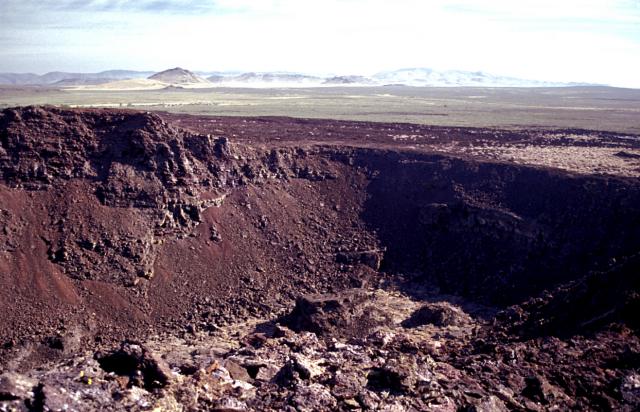Yellowstone lies in a semi-arid geographical region. In
simplest terms this means that the demand of water is greater than the supply
in any given area. This allows only the toughest of plant life to survive in
the region. The climate of Yellowstone varies drastically throughout the year,
potentially diving well below freezing in the winter months and high into the
nineties during warmer months. Due to such cold temperatures the Glaciers of
Yellowstone go through drastic changes as well which creates many of the
wonderful water and landscape features you can find within.
Glacial Erratics are a common form of landscape left behind by Glaciers. Although many of Yellowstone's landforms are formed by Volcanic activity there are many such as the above Erratic that are formed from former Glaciation in the region.
image courtesy of: http://travellogs.us/Miscellaneous/Geology/Glacial%20erratics/Glacial%20Erratic.htm
Yellowstone also lies within a Rhyolite Caldera (a large crater-like
hole), which was formed by the last explosion of the active super Volcano. The
Super Volcano supplies the heat needed for Yellowstone’s biggest attractions;
the geothermal activity.
Geothermal Activity in Yellowstone National Park fueled by the hot spot lying underneath the Earth's Surface
image courtesy of: http://www.slate.com/articles/health_and_science/the_green_lantern/2010/10/could_yellowstone_power_my_home.html
The many defining features of Yellowstone can help us to
predict what the area may look like in the future.
1,000 years
Yellowstone is filled with perennial meandering streams and
rivers meaning these water features flow year round. Due to the processes of
erosion and deposition the paths of the streams will likely change and move to
other areas of the landscape.
Meandering river that runs through Yellowstone National Park. You can see deposited material making almost a beach like area along the inside of the first bend in the river and the cutbank on the opposite side. Throughout time this will continue and ultimately change the direction and course of the river.
image courtesy of:http://www.bigskyfishing.com/National_parks/yellowstone/yellowstone_river_park.htm
The plant life will also most likely change in 1,000 years
due to the global climate change. We have already discovered a migration of
Pine Trees as time has progressed and climates have changed locally. Pine trees
rely heavily on colder temperatures. As temperatures in Yellowstone increase we
can most likely find the pine trees migrating towards climates that are more
suitable. If pattern continues this will be Northward.
10,000 years
In 10,000 years Yellowstone will encounter even further
drastic changes. Currently Yellowstone has many beautiful falls throughout the
Yellowstone River’s course. However, these most likely will not be existent in
the next 10,000 years. Due to erosion and undercutting we can expect that
eventually the stream will reach a point of equilibrium where the falls will no
longer be there and the river will run smooth.
As you can see in the diagram as water flows over the falls small rocks and debri are carried along which nibbles away at the soft rock underneath the hard surface. Once it has nibble away enough the hard rock will break and collapse causing the waterfall to retreat further.
image courtesy of:http://www.geocaching.com/seek/cache_details.aspx?guid=57d27ccb-1146-4214-a7d3-7f8ae880e754
We can also expect other landform changes from the rivers
and streams. The Yellowstone now runs through the mountains creating a narrow V-shaped canyon. This canyon will most likely grow larger and wider with time from
erosion and mass wasting along the steep slopes. Glaciation will also largely assist in widening the canyon. The ice that gets carried by the river will slowly start to round the sides of the canyon making it a parabolic canyon.
This image depicts what Yellowstone Canyon currently looks like. Notice the V-shape.
image courtesy of: http://commons.wikimedia.org/wiki/File:Grand_canyon_of_Yellowstone_and_Yellowstone_fall.jpg
The diagram above shows what could happen as the canyon Glaciates from hardened snow pack that doesn't completely melt in the warmer months. Eventually the glacier will nibble away at the steep slopes creating more of a porabolic shaped valley instead of the rigid V-shaped canyone we know now.
image courtesy of:http://www.uwgb.edu/dutchs/GeolColBk/MtnGlaciers.htm
1,000,000 years
Within the next million years it is quite possible that
Yellowstone’s Super volcano will erupt. In the case of this nearly every part
of Yellowstone as we know it will be destroyed and covered by magma. There will
no longer be the geothermal activity although as the hot spot continues to move
it they may develop once again further Northeast of the current location.
Conclusion
It is safe to say that within the next million years
Yellowstone will go through many drastic changes. Eventually Yellowstone will
be nothing like the gem we know today. It will be given a chance to wipe free
and rebuild to the glorious park it once was.
References
1. http://www.livescience.com/28821-yellowstone-supervolcano-bigger-plume.html
2.Class lectures on glacial and fluvial lnadscapes, Volcanism and erosion/mass wasting
http://clasfaculty.ucdenver.edu


























